|
- Global Warming and Tidal Rise in the Upper Keys -
By Jerry
Wilkinson
July,
2009
The new buzz words seems to be
Global Warming and Tidal Rising. Actually, it probably began with
Rachel Carson's book, Under the Sea
Wind, in 1941 published by Simon
& Schuster. My research shows it becoming a
subject of considerable discussion in the Keys
in the early 1960s, as a result of studies and exploration of the major
petroleum companies in the Keys areas. I say the Keys, but by far the
majority of exploration was in its
off-shore waters. Back in 1983, Hoffman. Keys and Titus in an U.S. E.
P. A. study forecasted the tides to rise from 1.4 to 2.2 cm per year
for
the next 100 years. Multiply cm by 0.3937 for inches which would be an
average of about three quarters of an inch per year, or slightly over
six feet in 100 years. Even using the lower rate of 1.4 cm would equate
to about 55 inches, or four and a half feet. From the charts below,
this would mean that
Stock Island, most of Big Pine and Lower Matecumbe Key will be under
water.
Ocean Reef would also be, but they have filled many of the
residential
lots to meet FEMA flood codes. All the access highways would however be
under
water! How about the salt water intrusion into the potable water
supply. Do not forget that Miami-Dade County will experience the same
sea level rise! One comment - few folk live full time at Stiltsville
off of Miami Beach.
In general, it could be generalized that the Lower
Keys would
cease to exist. According to D. M. Robbin in 1984 in Environments of South Florida, Past and
Present, a study of data from the past 8,000 years revealed that
the sea level has risen an average of 11 cm (4.33") per 100 years. Over
the past 8,000 year period this would equate to a 28.9 foot rise.
For
reference, this would have been the Archaic Period (8,000
b.c. to 750 b.c.) for the Paleo Native American Indian
period.
At the present for historical use,
I use figures from a Bob Carr archaeological report for which
credits a 'Scholl-1967.' For younger archaeological sites such as ours
in the Upper Keys, 3,000 years ago (BP) to present use 3.5 cm per 100
yea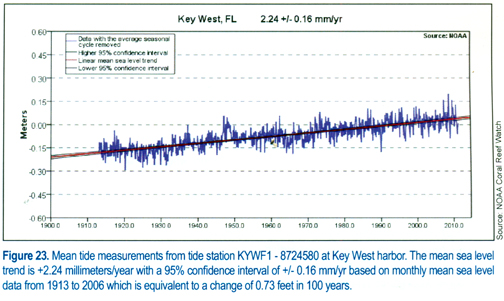 rs. For older Florida sites between
6,000 to 3,000 years ago
use 2.54 cm per 100 years. rs. For older Florida sites between
6,000 to 3,000 years ago
use 2.54 cm per 100 years.
Now for one more published in the
Florida Key National Marine Sanctuary Condition Report 2011, page 35.
To the right is a color graph for tide station KYWF-18724580 at Key
West Harbor. The mean sea level change from 1913 to 2006 is 0.73 feet
in 100 years.
For reference purposes NOAA
announced the adjusted level of carbon dioxide in the atmosphere in May
2013 was 399.89 parts per million. NOAA has been tracking CO2
levels for 50 years.
Now for the future - A 2009
report from a "international climate
panel" report given at Marathon predicted a best-case 17.8 cm (7
inches) rise and the worse case as 59 cm (23.2 inches) rise for the
21st century. This 88 years more of the 20th century for a 7 inch rise
or, 0.08 inches per year, or 0.8 inches per decade.
Suggest one consider/analyze
articles about future tidal rises. A recent Miami Herald (3/23/12)
article wrote that the sea level rose 8 inches from 1880 to 2012 - 132
year period. This would give a rise of one inch every 16.5 years.
Further into the article it was predicted that by 2050.a a period of 38
years, the sea level was predicted to rise 4 feet. Dividing the 16.5
years for one inch of rise into the 38 year span, it will only be a 2.3
inch rise - not 4 feet. If we use the 16.5 years for one inch, in the
year of 2112 (100 years) it will have risen 6.06 inches.
Before I move on to charts/maps
depicting
results of a one meter (~39
inch) rise at selected areas, I suggest that one might visit the Internet for more predictions. Starting with
"Wikipedia" at http://en.wikipedia.org/wiki/Sea_level is as good
as any, but do not suggest that it is final! Then one editorial
statement - the present sea level has been
rising for
about 18,000 years, and 100,000 years ago, published books say one
could have walked to the reef. Using an October 1976 NOAA
Nautical Chart 1145,1 the deepest water proceeding directly off
Key Largo through Hawk Channel to Carysfort Reef is 26 feet, to The
Elbow is 33 feet, to Molasses Reef is 29 feet, Pickles Reef is 21 feet,
to Conch Reef is 23 feet and to Alligator Reef is 16 feet. The early
residents would have be first able to walk to Alligator Reef, and next
to Pickles Reef.
First, the
seas will not just rise in the
Keys, or just in Florida - for certain it will rise through out
the Northern
Hemisphere - and since water seeks its own level it will rise to
some extent around the globe. Secondly, when we address 100 year
increments please look back just one increment to say 1909 to compare
history. 500 years ago, Ponce de Leon as yet sailed to seek his
legendary Fountain of Youth.
The following presentation
is from an abstract of LIDZ, B.H.
and SHINN, E.A., 1990, Paleoshorelines, Reefs, and a Rising Sea: South
Florida, U.S.A., Journal of Coastal
Research, 7(1), 203-229 Fort Lauderdale, ISSN 0749-0208,
published by U.S. Geological Survey, Center for Coastal Studies, 600
4th St. South, St. Petersburg, FL 33701, U.S.A. This is a valuable
document. After the introduction, first are shown charts of the Keys
shorelines 8,000 years before present, then 6,000 years and then
2,000 years - a great primer of how the Keys developed. The last part
are charts showing the Keys after one meter of sea level rise, then
charts of 2 meters, 3 meters, 4 meters and 5 meters rise in sea level.
The conclusion is all vestiges of the Keys will be under water with a 5
meter rise.
Space allows for most of the charts to
be
presented, but the idea should established. There may extra spaces
between some charts. In the Keys at the
five-meter sea
rise, only five peaks will survive: Solares Hill (Key West), Lignum
Vitae Key,
Windley Key and two on Plantation Key. 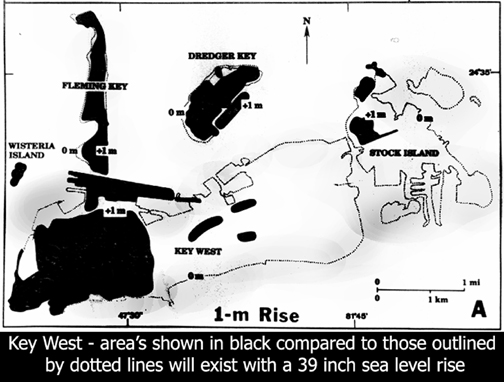 I will present
the charts
from south to north. The method used
is the present island, or island's, boundaries are outlined with dotted
lines,
unfortunately these are very light (dim) in contrast, so look closely.
When I
do include selected depths other than one meter, the dotted lines show
the change from the previous depth and not the original shore line.
Click on a chart to enlarge to its original size. The areas shaded in
black
will be above sea level. In the publication, all five levels are shown
for comparison - I am only showing a one meter (39 inches) increase -
even using the worse-case scenarios, the areas in black will exist.
(One meter equals 39.37 inches, 3.281 feet or 1.0984 yards) These
charts do not consider the approximately two to three foot lunar tides,
or storm surges, or wind driven waves on top of a storm surge. Let's
try a one meter sea rise chart beginning with Key West and Stock Island
shown at the right. I will present
the charts
from south to north. The method used
is the present island, or island's, boundaries are outlined with dotted
lines,
unfortunately these are very light (dim) in contrast, so look closely.
When I
do include selected depths other than one meter, the dotted lines show
the change from the previous depth and not the original shore line.
Click on a chart to enlarge to its original size. The areas shaded in
black
will be above sea level. In the publication, all five levels are shown
for comparison - I am only showing a one meter (39 inches) increase -
even using the worse-case scenarios, the areas in black will exist.
(One meter equals 39.37 inches, 3.281 feet or 1.0984 yards) These
charts do not consider the approximately two to three foot lunar tides,
or storm surges, or wind driven waves on top of a storm surge. Let's
try a one meter sea rise chart beginning with Key West and Stock Island
shown at the right.
Lets remember that
this is from a 1990 publication, but the island profiles have
not changed that much in 19 years. I have not provided the 2, 3, 4, and
5 meter charts, but all of Stock Island will
be submerged at 2
meters. This is true for the remaining Lower Keys. Only one spot on
Sugarloaf and Cudjoe Keys will survive. There is a speck on Cudjoe Key
that
survives at 3 meters. All the surrounding areas near Solares Hill at Key West survives 2
meters, the principal top of Solares Hill remains at 3 meters, the very
top at 4 meters and a tiny speck at 5
meters. speck at 5
meters.
Moving northward from
Key West is a chart of the Big Pine Key area. There will be a lot of
blank spaces between charts from here on,
especially beginning with a portrait shaped chart. I could have skipped
this one, but the authors took a whole page for this illustration,
so here it is at the right. [Different Internet browsers display
differently. I have captions at the bottom of each chart that might
assist-JW]
There are major implications to
what will happen to the much loved
Florida Keys off shore reefs. Lidz and Shinn discuss the changes
to come as
the present Outer Reefs die because of increasing water depth (loss of
photothensis and cooler water) and the present Inner Reefs will take
their
place. It will not be a linear change as the present Outer Reefs have
the extremely deep and steep slope of the Continental Shelf upwelling
waters. They assume that the shelf will not change drastically.
--
--

Now for
the Middle Keys. It is clear that other than the airport, the
southern part of Marathon is the highest. I am not certain whether this
was filled by man - it appears so - or if it was a natural coral hump.
The northern Middle
Keys are on the smaller chart over the Key Vaca chart. These are the
only two
charts in the booklet. Again, only the one meter rise is shown.
-
-
--
Now to the Upper
Keys again from south to north 
beginning with Lower and Upper Matecumbe Keys.
Lower Matecumbe Key basically disappears after a
a one-meter sea rise. Like most of Key Largo, Upper
Matecumbe has a ridge. A two meter chart is above the one meter
chart.
-
-
--
More Upper Keys showing
Windley
and Plantation Keys: 
The four and five meter rises are not given, but the northern Windley
Key quarry area will
be the last to submerge.
-
-
-
-
-
-
-
-
-
-
-
-
I will divide Key Largo into three parts - Southern,
Middle and 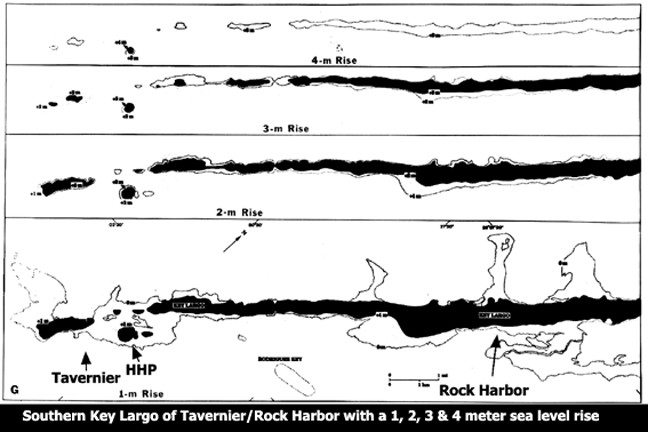
Northern - southern Key Largo is shown first. There is significantly high knoll
in the Harry Harris Park area. Note that the knoll survives even a
four-meter
rise in sea level. 2, 3, and 4 meter charts are also shown.
-
-
-
-
-
-
-
-
Now for Middle Key Largo: 
-
-
-
-
-
-
-
-
-
-
-
-
-
-
-
And the last parts are North Key Largo,
Angler's Club and Ocean Reef: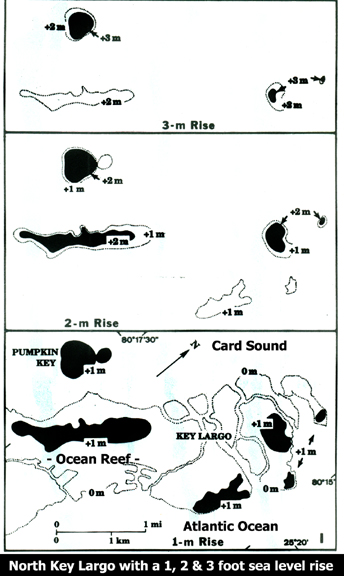
-
-
-
-
-
-
-
-
-
-
-
-
-
-
-
-
-
Elliott Key: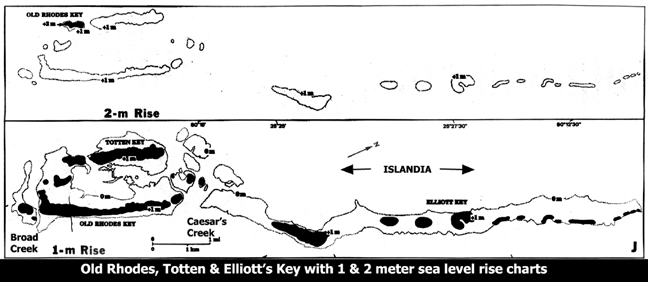
-
-
-
-
-
-
-
-
NOAA does have a web page on sea level at:
http://co-ops.nos.noaa.gov/sltrends/sltrends.shtml
Sources:
Land from the Sea by
John Edward Hoffmeister, 1974;
Geology of the
Florida
Keys by Eugene A. Shinn, Oceanus, 1988 and Paleoshorelines,
Reefs, and
a Rising Sea: South Florida, U.S.A. by Barbara H. Lidz and Eugene A.
Shinn,
1990.
Additional reading:
Rachel Louise Carson (May 27,
1907 – April 14, 1964)
"Under the Sea Wind" , 1941, Simon &
Schuster,
"The Sea Around Us", 1951, Oxford
University Press
"The Edge of the Sea", 1955,
Mariner Books,
"Silent Spring", Houghton
Mifflin, 1962
-----End-----
Use the back arrow to return to Keys Geology
|